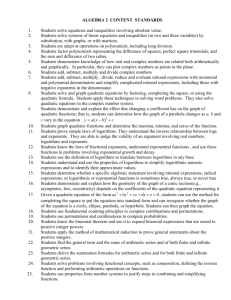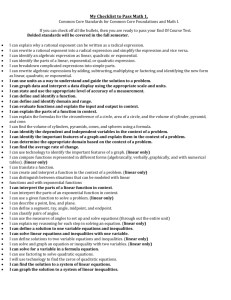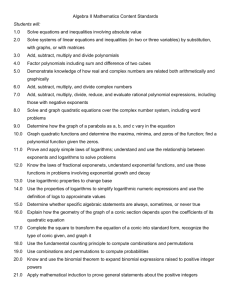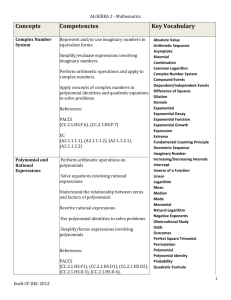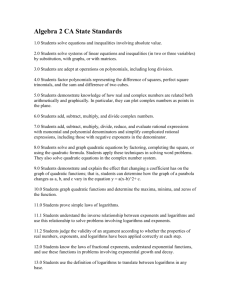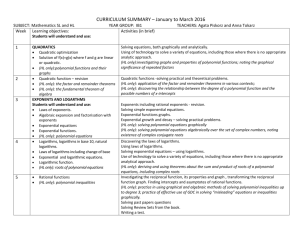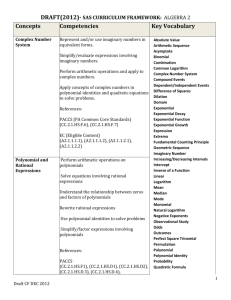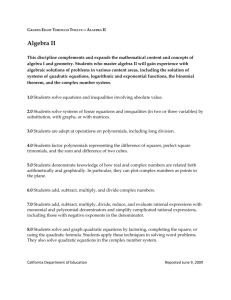Mathematics HL
advertisement
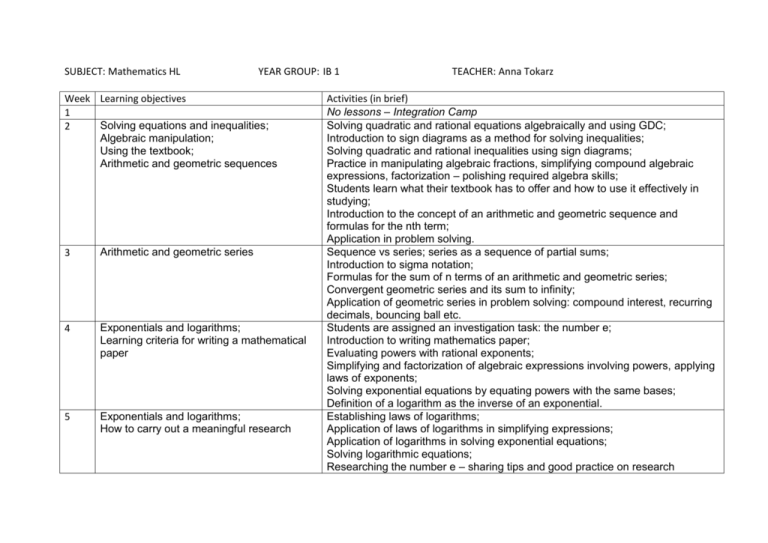
SUBJECT: Mathematics HL YEAR GROUP: IB 1 Week Learning objectives 1 Solving equations and inequalities; 2 Algebraic manipulation; Using the textbook; Arithmetic and geometric sequences 3 Arithmetic and geometric series 4 Exponentials and logarithms; Learning criteria for writing a mathematical paper 5 Exponentials and logarithms; How to carry out a meaningful research TEACHER: Anna Tokarz Activities (in brief) No lessons – Integration Camp Solving quadratic and rational equations algebraically and using GDC; Introduction to sign diagrams as a method for solving inequalities; Solving quadratic and rational inequalities using sign diagrams; Practice in manipulating algebraic fractions, simplifying compound algebraic expressions, factorization – polishing required algebra skills; Students learn what their textbook has to offer and how to use it effectively in studying; Introduction to the concept of an arithmetic and geometric sequence and formulas for the nth term; Application in problem solving. Sequence vs series; series as a sequence of partial sums; Introduction to sigma notation; Formulas for the sum of n terms of an arithmetic and geometric series; Convergent geometric series and its sum to infinity; Application of geometric series in problem solving: compound interest, recurring decimals, bouncing ball etc. Students are assigned an investigation task: the number e; Introduction to writing mathematics paper; Evaluating powers with rational exponents; Simplifying and factorization of algebraic expressions involving powers, applying laws of exponents; Solving exponential equations by equating powers with the same bases; Definition of a logarithm as the inverse of an exponential. Establishing laws of logarithms; Application of laws of logarithms in simplifying expressions; Application of logarithms in solving exponential equations; Solving logarithmic equations; Researching the number e – sharing tips and good practice on research 6 7 The irrational number e; Natural logarithm; Assessment of a written maths paper Functions; Transforming graphs of functions 8 Quadratic and rational functions; Using mathematics to model real life situations. 9 Exponential and logarithmic functions as inverse functions; Exponential growth and decay 10 Complex numbers in Cartesian form 11 Quadratic equations 12 Polynomial functions techniques. Introduction to natural logarithm; Learning how to assess a written maths paper against the given criteria; Peer assessment of a written maths paper. Theory of functions: definition, one-to-one function, inverse functions and composite functions, domain and range; Definition of monotonicity of functions, techniques of testing monotonicity; Definition of odd and even functions; techniques of testing; Basic transformations: translations, stretches and reflections in the axes; Reflection in the line y=x , as a result graph of the inverse function; Transformations with absolute value and reciprocal of y=f(x). Properties of quadratic functions; Finding a quadratic from its graph; Application of a discriminant to find the number of roots; Graph and properties of a rational function f(x) = (ax + b)/(cx + d) including equations of asymptotes and intercepts; Solving real life problems using quadratics, including optimization problems. Graphs and properties of exponential and logarithmic functions; Solving real life problems involving exponential growth and decay; Solving past exam questions. Introduction to the concept of an imaginary number i ; Finding the real part, the imaginary part, complex conjugates modulus and argument of a complex number; representation on a complex number in Argand diagram; Manipulating complex numbers in Cartesian form Solving quadratic equations over the set of complex numbers; Sum and product of roots of a quadratic equation; Use of the discriminant with application in solving problems with parameters; Manipulating polynomials: addition, subtraction, multiplication and division (long division and synthetic division); Investigation of graphs of polynomial functions, graphical significance of 13 Theorems of polynomials 14 Polynomial equations 15 Binomial expansion repeated roots The factor theorem, the remainder theorem and the fundamental theorem of algebra with applications. Solving polynomial equations graphically (use of GDC) and algebraically; Sum and product of roots of polynomial equations Finding coefficient of a given term, product of two binomial expansions, how to expand a quadratic trinomial, application in evaluating decimal.


